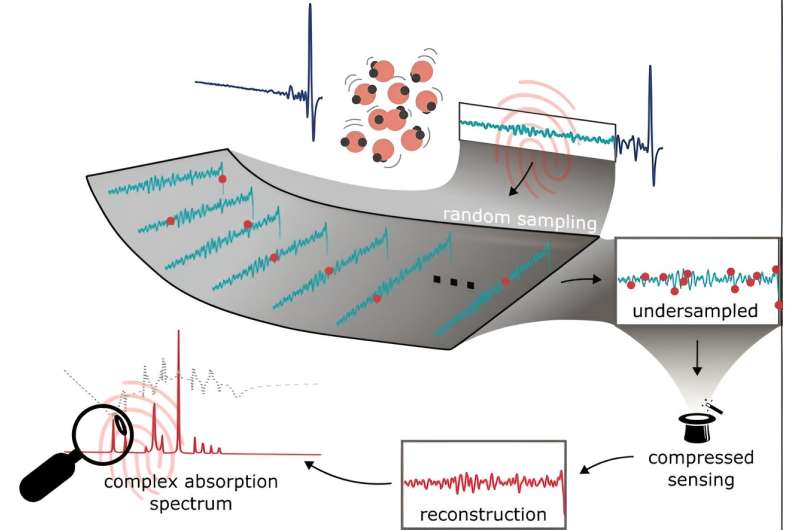A visual summary of field-resolved molecular fingerprint compressed sensing. Credit: ultrafast science (2024). DOI: 10.34133/ultrafastscience.0062
Ultrashort pulses play an important role in spectroscopy applications. Their wide spectral bandwidth enables simultaneous characterization of samples at different frequencies, eliminating the need for repeated measurements or laser tuning. Furthermore, their extreme temporal confinement allows temporal isolation of the sample response from the main excitation pulse.
This response carries comprehensive spectral information, lasting from tens of femtoseconds to nanoseconds (10−15 to 10−9 seconds) and are usually detected by shorter pulses with varying time delays. When combined with other techniques such as multidimensional coherence spectroscopy or hyperspectral imaging, ultrafast spectroscopy can help identify unknown components.
However, the ambition of real-time measurement faces obstacles, mainly because each pixel requires a large amount of data to be recorded over a high-bandwidth spectrum, thereby introducing considerable delays in data acquisition, extending processing time and increasing data volume.
Researchers have developed a technique to speed up spectral analysis. Kilian Scheffter, a PhD student working with Hanieh Fattahi, leader of the Femtosecond Field Mirrors group at MPL, explains: “In many samples, the molecular response to ultrashort excitation pulses is often sparse, which means The response that occurs only at specific frequencies is called a molecular fingerprint.
“By strategically randomizing measurement points in time, an established method called compressed sensing can efficiently reconstruct a signal using fewer data points than the constraints dictated by the Nyquist criterion. However, the main challenge is changing the probe The timing of the overlapping pulses and femtosecond excitation pulses is random.
“Working with partners in Germany and France, we succeeded in using sound waves to randomly modulate this temporal overlap. This innovation extends the application of compressed sensing to real-time spectroscopic measurements.”
“Accelerated time-domain spectroscopy offers multiple advantages, such as simplified label-free imaging of fragile samples, point-of-care environmental monitoring and open-air diagnostics of toxic and harmful gases, and molecular endoscopy,” said Dr. Hanieh Fattahi.
Works published in journals ultrafast science.
More information:
Hanieh Fattahi et al., Compressed sensing of field-resolved molecular fingerprints beyond the Nyquist frequency, ultrafast science (2024). DOI: 10.34133/ultrafastscience.0062
Provided by the Max Planck Society
citation: Molecular Fingerprints Beyond the Nyquist Frequency (2024, April 24), Retrieved April 25, 2024, from https://phys.org/news/2024-04-molecular-fingerprint-nyquist-Frequency. html
This document is protected by copyright. No part may be reproduced without written permission except in the interests of fair dealing for private study or research purposes. Content is for reference only.
#Molecular #fingerprints #Nyquist #frequency
Image Source : phys.org
